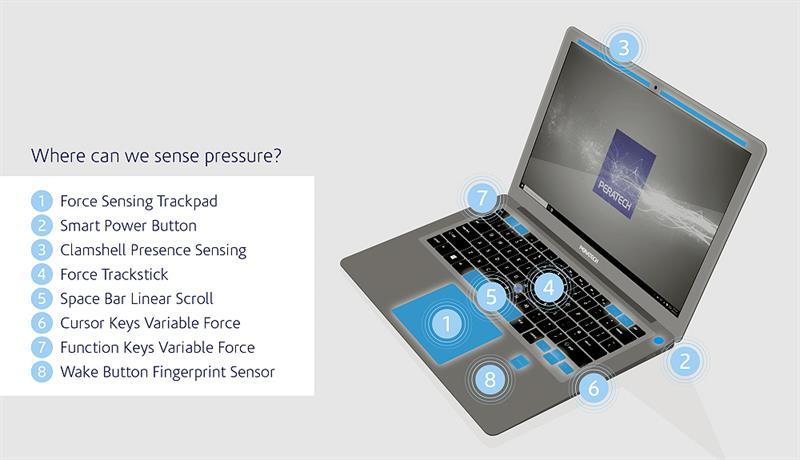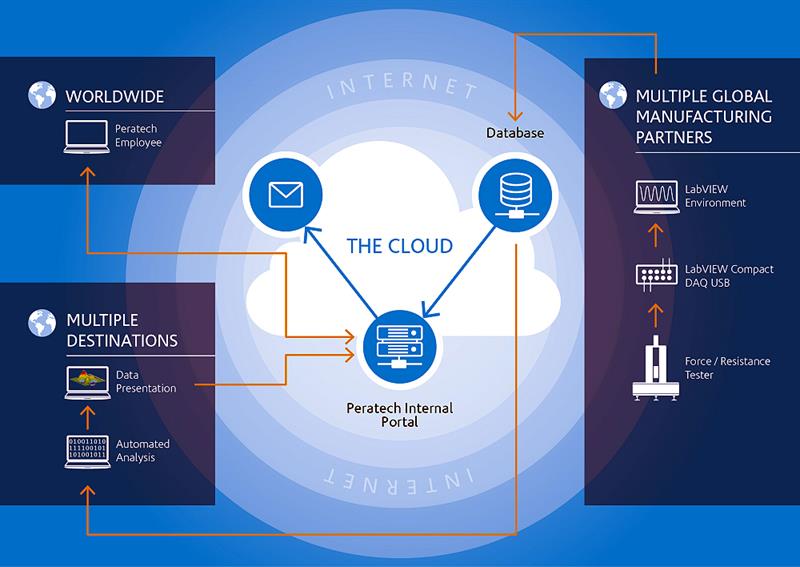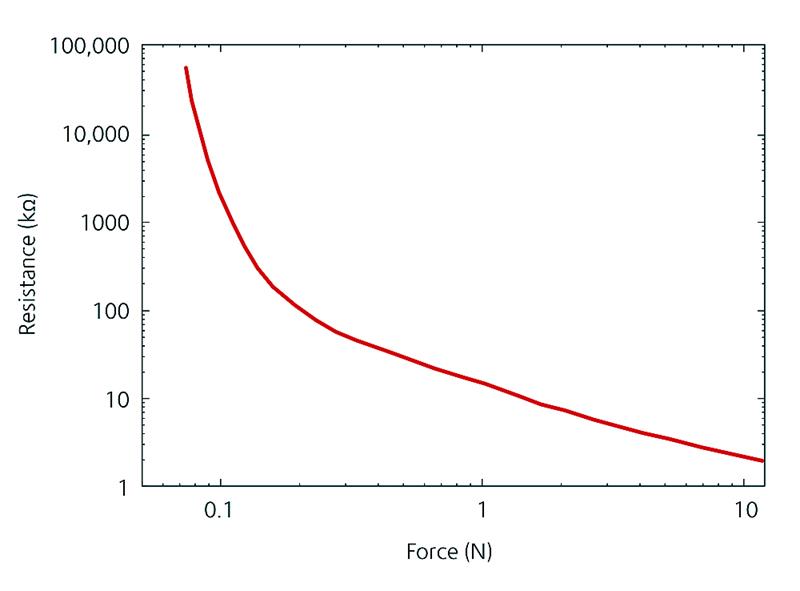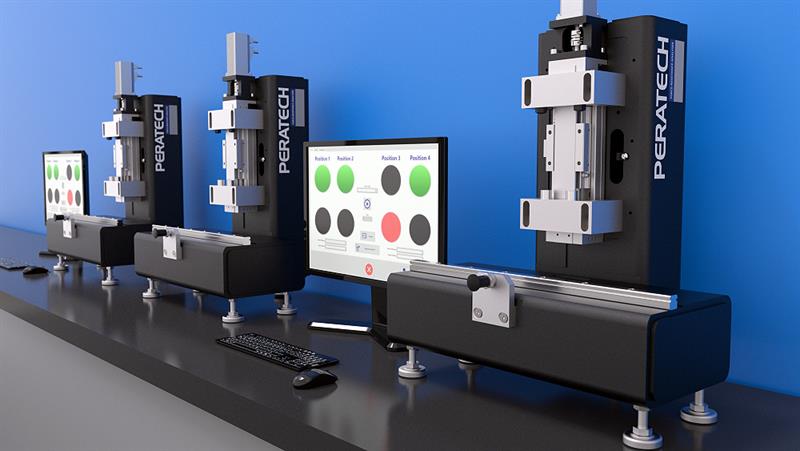Force touch sensors are transforming our interactions with everyday machines
In addition to displays, phone and tablet makers can add interaction opportunities by incorporating force sensors into other parts of their devices, such as the home button, power button, or volume controls. Some manufacturers are adding an area of force sensitivity to the sides or rear of the device, thereby creating additional interaction methods that don’t involve your fingers obscuring parts of the display. The most basic example of one of the improvements force sensing provides is that you do not have to repeatedly lift your finger away from contacting the button to get the button to advance repeated times, an especially valuable feature for one-handed volume control.
Personal computer manufacturers are exploring how to build force sensors into other parts of the hardware, including the keyboard. Imagine a light press on the arrow keys moving your cursor along letter by letter, while a harder press jumps through a word at a time. Now, a deliberate, intuitive level of pressure, not an arbitrary measure of time determines the difference in the two actions from the same button.

Figure 2: Integrating appropriate force sensors into laptops and notebooks enables a more intuitive user experience (Source: Peratech)
A force sensor can replace mechanical switches in almost any application where analogue control can provide a more intuitive experience. The ultrathin design and the high durability that force sensors enable, can save space, increase life, and reduce the total cost of ownership over traditional button systems.
Some other potential uses of force-based controls and sensors include: variable speed power tools or appliances, fitness equipment, home automation, automotive controls, biometric characterisation, and industrial or robotic systems.
Essential characteristics of force touch sensors
As these applications show, the uses for force sensors are many and varied, but all share common requirements.
The first essential requirement is that the sensor be the right fit for purpose.Under-specified and you have a poor-performing product. Over-specified and cost, complexity, and potentially quality become unnecessary challenges.For example, sensor precision can vary depending on how much force is applied. You need to know the sensor module you’re using gives the necessary accuracy at the ranges of force you’ll be subjecting it to. There’s little value in knowing a sensor will offer variances of no more than 10g at forces of 1kg if the greatest force it will face in use is 100g. If variance in precision of sensing from 10g to 100g is the most important to you, then that specification is what your sensors should be measured against. Another aspect of this requirement is that the specification must directly and accurately correlate to desired performance, otherwise you’re in danger of accurately measuring something that has no bearing on your actual product performance.
The second essential requirement is that performance to specification must be predictable and reliable. From a technical perspective, this means that the sensor output must be accurate to a specified variance throughout the usable force range.
The final essential requirement is that sensors need to be produced at required volumes, while still providing the quality assurance we’ve outlined. This means that the testing employed must not only be accurate and applicable, but be simple to perform, fast, and scalable. All of this needs to be embodied in a cost-effective piece of test equipment.
Achieving confidence in your force sensors
For manufacturers incorporating force sensors into equipment where a medium or high level of precision is required – which is a requirement in the smartphone and premium notebook use cases highlighted above – the only way to achieve the necessary confidence in the sensors is with intelligent and thorough testing.
Testing a representative sample from a production run doesn’t give sufficient confidence when you need every unit to be of the prerequisite quality. Similarly, only testing a sensor at one force point is of little value, unless that force point matches your use case exactly.
Instead, you need to know each sensor works at the appropriate level of force, which generally means that device manufacturers must carry out their own time-consuming and costly testing to ensure the sensor they’ve chosen is suitable –even after all the testing that sensor companies perform.
To reduce this need for its customers to perform unnecessary and expensive testing, Peratech, has developed a rigorous, next-generation product testing and analysis approach that accurately characterises that sensor modules are fit for purpose, then efficiently assesses sensors as they come off the production line.
Next-generation sensor testing: delivering high customer confidence
By combining testing hardware and software from National Instruments (NI) with a bespoke data infrastructure that uses cloud and business intelligence/analytics tools, Peratech has designed and implemented a new, secure automated testing and monitoring system that can be used in any facility manufacturing its sensors.

Figure 3: The testing setup automatically captures test data off every production line, stores it in the cloud and makes it available for further analysis (Source: Peratech)
The system automatically tests every single sensor that rolls off a production line, using National Instruments equipment and LabVIEW software. The process subjects each sensor to a range of forces in less than 5s, collecting up to 50,000 data points per second to produce a complete force-resistance curve.

Figure 4: A complete force-resistance curve shows how a sensor will perform at different levels of force (Source: Peratech).
Thanks to the automation, this high level of assurance and depth of testing can be achieved while adding only pennies to the production cost of each unit.
Data-driven decisions
Data from the tests is distilled down and securely stored in the cloud, where it can be analysed from anywhere in the world in near-real time. This enables Peratech to identify and resolve problems in minutes instead of days, and provides instant and continuous assurance of quality levels.
For customers, this rigorous factory testing and the insights it produces can reduce or even eradicate the need for their own trial-and-error testing to find a suitable sensor. It can also cut incoming inspection and end-product testing time. Should unforeseen product issues arise, the system provides product traceability, enabling high-speed forensics and problem solving. As a result, not only does Peratech’s sensing solutions enable next generation HMI product applications but Peratech’s product assurance and traceability solutions reduce risk and uncertainty of getting a product from concept development to mass production more quickly, with better quality, and at lower cost.

Fig 5: Testing bench (Source: Peratech)
Informing and accelerating new product development
As well as providing assurance of the quality of off-the-shelf products, the vast store of test data can be analysed to inform development of new standard and bespoke sensors.
Peratech can use a variety of data visualisation tools to analyse the data, completing experiments faster and focusing their resources on analysis and insights leading to much better and more consistent sensor performance in a range of custom shapes and sizes, using the optimal materials.
Moreover, the testing system can quickly be modified to test new product designs, without the need for complex, low-level coding. As a result, setting up the tests for new sensors takes weeks rather than months.
All of this means that those wanting a bespoke sensor for their product can get the new component in their hands, complete with the assurances of quality and fitness for purpose, much more rapidly than would otherwise have been possible.’
Conclusion
To ensure sensors perform predictably and provide the required level of precision for their specific use cases, sensors must be characterised and relentlessly tested before being released into the market. This typically requires device manufacturers to perform their own extensive tests, which are expensive, time-consuming, and may not accurately correlate sensor performance to product performance requirements.
Peratech has developed an automated, scalable, and data-driven test approach that ensures every sensor it produces is tested against a range of forces that apply exactly to customers’ product application needs.
Author profile
Dr Tim Wiles is a signal processing and analysis engineer at Peratech.













